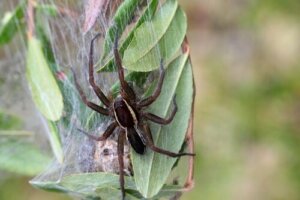Arachnophobia, the Irrational Fear of Spiders


Written and verified by the doctor Leonardo Biolatto
Arachnophobia is one of the most common fears in humans. This is striking considering spiders are one of the most common household animals. It’s strange that so many people are actually afraid of them.
Venomous spider species are truly rare and yet those with arachnophobia are convinced that these animals can greatly harm them. Obviously, this isn’t a rational fear as these insects are harmless for the most part.
Arachnophobia is so extreme that some people experience panic at the mere thought of spiders. Others aren’t so extreme but the fear of this animal’s presence nearby limits their quality of life. Why does it happen? Is there a way to solve it?
What’s arachnophobia?

As many people know, arachnophobia is the irrational fear of spiders. A phobia is basically a disorder characterized by extreme fear of a specific object or situation. It goes beyond a normal fear and, in some cases, its intensity significantly limits a person’s life.
Estimates indicate that phobias are the most common mental disorder in women and the second most prevalent among men over the age of 25. Also, the irrationality of this fear lies in the disproportion between the feared object or situation and the level of threat these represent.
Read about Haphephobia and How to Overcome It
The interesting causes of this phobia
The general opinion among scientists is that arachnophobia begins in childhood and it’s a learned fear, depending on the threats and inappropriate behavior of adults. On this note, Sigmund Freud considered that all phobias are an unconscious displacement. That is, the child’s real fear transfers to a harmless object because it rejects the existence of the primordial fear.
Recently, an interesting theory about the fear of spiders came out. Scientists at the Max Planck Institute for Human Cognitive and Brain Sciences in Leipzig, Germany developed it and published it in the journal Frontiers in Psychology.
According to these scientists, the fear of spiders is genetic and transmitted from generation to generation. To test this theory, the researchers took a group of babies and presented them with various images. The objective was to measure the level of anxiety each image provoked in them. (They evaluated the degree of dilation of their pupils.)
The result was the babies showed greater signs of anxiety when presented with images of snakes or spiders. However, fish and flowers calmed them down. Thus, the researchers concluded that arachnophobia happens when a negative experience with these animals adds to this natural repulsion.
Manifestations of arachnophobia

The symptoms of arachnophobia are similar to those of other phobias and include:
- Heart twitching and elevated heart rate
- Palpitations and sweating
- Tremors and a feeling of tightness in the chest
- Nausea, dizziness, and fainting
- A sensation of suffocation and unreality
- Chills or suffocation
- Agitated breathing and temporary paralysis
- The fear of losing control and dying
Possible solutions
Everything indicates that the most effective treatment to overcome this irrational fear of spiders is exposure therapy. Thus, the help of a psychologist is needed to carry out this therapy. The first thing they do is come up with a subjective anxiety scale. This measure allows them to establish the degree of the phobia.
The psychologist usually asks the patient to rate the level of anxiety caused by various situations, from 1 to 100. Then, some of the situations they inquired about are:
- Reading the word spider in a book
- Talking to someone about spiders
- Seeing a spider in a movie
- Going for a walk in the countryside
- Knowing there are spiders nearby
- Seeing a spider from far away
- Seeing a spider near
- Finally, holding a spider
As you can see, exposure to fear initiates based on the score of each situation, virtually, at first. The objective is for the person to tolerate the object of their fear until they overcome it. Then, they’ll do the same thing but with actual exposure for the purpose of obtaining the same result.
All cited sources were thoroughly reviewed by our team to ensure their quality, reliability, currency, and validity. The bibliography of this article was considered reliable and of academic or scientific accuracy.
- Maldonado-Durán, M., & Lartigue, T. (2008). Trastornos de ansiedad en la etapa perinatal. Perinatología y Reproducción Humana, 22(2), 100-110.
- Uppsala University. (2017, 18 octubre). Itsy Bitsy Spider…: Infants React with Increased Arousal to Spiders and Snakes. Recuperado 5 abril, 2020, de https://www.frontiersin.org/articles/10.3389/fpsyg.2017.01710/full
- Götestam, K. G., & Hokstad, A. (2002). Tratamiento en sesión única de la Aracnofobia en grupo mediante Exposición Rotativa Activa. The European journal of psychiatry (edición en español), 16(3), 133-138.
This text is provided for informational purposes only and does not replace consultation with a professional. If in doubt, consult your specialist.








